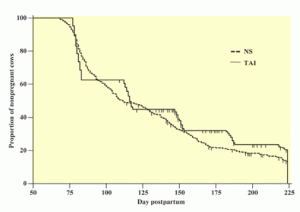Artificial insemination (AI) and heat detection
Natural Service Vs. Timed AI

Natural service (NS) and timed artificial insemination (TAI) are two breeding programs widely used by dairy producers as a strategy to minimize poor estrus detection of high producing lactating dairy cows. The use of NS in the US has been reported to range from 43 per cent to 75 per cent of the breeding program used for lactating dairy cows. The use of TAI is also widespread in the US. NAHMS (2009) reported in 2007 that 58 per cent of dairy farms used TAI programs to manage reproduction in both heifers and cows. Recently, a field study conducted in Florida compared reproductive performance of lactating dairy cows in a commercial dairy farm with cows bred by NS or TAI. A second study using the data from this field trial was performed to compare the cost of these two breeding programs.
Results from the field study showed that 21 days cycle pregnancy rates, which included a total of 8 and 5 service opportunities for NS and TAI, respectively, was not different between the groups (25.7 per cent and 25.0 per cent for NS and TAI, respectively). The daily rate of pregnancy was 15 per cent greater (e.g. 1.41 per cent vs. 1.22 per cent ) for NS than TAI, which resulted in fewer median days open (111 vs. 116 days) and a greater proportion of pregnant cows at 223 days in milk was greater for NS (Figure 1).
The greater proportion of pregnant cows observed in the NS group at the end of the study was attributed to differences in breeding dynamics between groups. In the NS group, bulls had the potential for daily detection of estrus and breeding of nonpregnant cows. On the other hand, because of the TAI resynchronization scheme, nonpregnant cows in this group required 35 day to be reinseminated, and thus the number of days to become pregnant increased. Therefore within this scenario, cows in the TAI group had only 5 opportunities to be bred compared with a potential 8 times for cows in the NS group up to 223 days in milk. The increased median number of days to pregnancy observed for TAI cows can also be attributed to this difference in breeding opportunities. A greater number of nonpregnant cows in the NS group had earlier opportunities to be bred than TAI cows under the same 21"day cycle pregnancy rates; consequently the final outcome for median time to pregnancy favored the NS. Therefore, the greater interval between inseminations reduced the proportion of pregnant cows on the TAI breeding program.

Figure 1. Survival curves for proportion of nonpregnant cows by days in milk (DIM) for cows bred by natural service (NS) or timed AI (TAI) in the first 223 DIM. Median interval to pregnancy for NS and TAI groups was 111 (95 per cent confidence interval [CI] = 104 to 125 days) and 116 DIM (95 per cent CI = 115 to 117 days), respectively. The rate of pregnancy in the 223 DIM was greater for NS than TAI (adjusted hazard ratio = 1.15; 95 per cent CI = 1.00 to 1.31).
The second study used the reproductive performance results obtained in the first study as a platform to compare the cost of NS and TAI. A herd budget accounting for all costs and revenues was created. The final results showed a net cost for the NS program of $100.49/cow per year and for the TAI program of $67.80/cow per year, unadjusted for differences in voluntary waiting period (VWP) for first insemination and the minor differences in pregnancy rates. After inclusion of the differences in VWP and pregnancy rates, the economic advantage of the TAI program was $9.73/cow per year. Costs per day of cow eligible for insemination was $1.45 for the NS program and $1.06 for the TAI program. When marginal feed cost was increased from $3 to $5/cwt (1 cwt = 45.36 kg), the advantage of TAI increased to $48.32/cow per year. If higher milk prices and greater genetic progress were assumed, the advantage of TAI increased. When semen price increased from $6 to $22, the NS program had an economic advantage of $33.29/cow per year. If each NS bull was replaced by an additional cow, the advantage of the TAI program was $60.81/cow per year. Using a pregnancy rate for both programs of 18 per cent and the VWP at 80 days, there was an advantage of $37.87/cow per year for the TAI program.
The major factor that influenced the greater cost of NS was the cost of feeding the bulls, which was 38 and 61 per cent of total bull costs ($163.59) and net cost ($100.49), respectively, for NS. Semen cost and genetic merit were the variables that caused the biggest impact on the profitability of TAI. In conclusion, the slight advantage of NS in reproductive performance with a greater proportion of pregnant cows after 223 days in milk was offset by a cost advantage in favor of the TAI breeding program. The use of NS bulls is not necessarily a more expensive method for breeding cows to avoid problems related to estrus detection. An increase in AI semen cost could result in a cost advantage of the NS program. However, an increase in marginal feed cost and a greater genetic advantage from AI sires would increase the economic advantage of the TAI program.






















